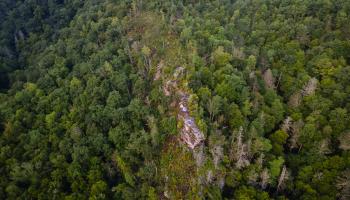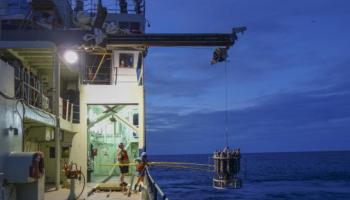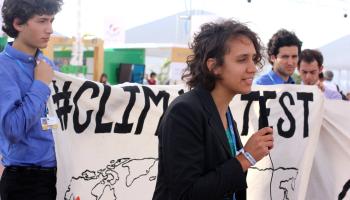El Nino and Its High Temps Are Back in An Already Hot World. What Does It Mean?

El Nino has returned.
The National Oceanic and Atmospheric Administration made the declaration June 8 and that means the natural, cyclical warming pattern has returned to the Pacific Ocean, bringing with it a cascade of weather events including more predicted rain in the southern United States, higher temperatures around the globe, and even the giant wildfires in Canada that came early this spring.
El Nino and its higher temperatures also arrive at a pivotal time as the past eight years are the hottest on record, according to the World Meteorological Organization.
Deborah Lawrence is a University of Virginia professor of environmental science and a climate change expert who has been featured in UVA Today regularly over the years. In past years, she’s struck a cautiously optimistic tone. She was featured in 2019 after her research was used in a United Nations’ Intergovernmental Panel on Climate Change. In the article, she was asked if the world had enough time to make an impact on climate change “before reaching a tipping point toward a dangerously altered climate.”
Q&A: What’s Next With the Brunt Ice Shelf Break? And What About the Penguins?
Her response was hopeful: “We still have time, but we need to move quickly,” she said then. “For the safest climate future, the last [Intergovernmental Panel on Climate Change] special report said we need to limit warming to 1.5° C, not the 2°C agreed to in [the 2015] Paris [Agreement.] That means turning our energy system around in the next five to 10 years. Instead of emitting more greenhouse gases every year, we need to reduce emissions by 5% to 10% every year – hitting a 50% reduction by 2030 and zero emissions by 2050. This is fast, but not crazy.”
But when we reached out to talk about El Nino, her tone had markedly changed.
Q. What do you expect El Nino’s effects are going to be around the globe?
A. This time, it’s actually terrifying to me – for the first time. I think of independent disasters around the globe. The place that I love most is the forest of Indonesia, the rainforests and the peat forests, and they burn every time we have an El Nino. They are wet, wet forests that are not supposed to burn, and yet they burn like crazy when we have an El Nino.
There could be some good news in places, but good news in a warming climate never is good news, like more moisture in the South and in the Southwest. You’d think that might be great for the U.S., but it could mean terrible floods. It could be awful.
I worry about fires in Asia. We’re already seeing fires here in North America, but the biggest thing I’m worried about is that we’re going to just see excruciating heat. I saw a report that said in the next five years, perhaps sooner, during this El Nino, we’re going to surpass 1.5 degrees [an average annual temperatures]. And that just makes my heart sink because we’re at 1.1 degrees warmer than in 1900. We are supposed to stay below 1.5 degrees, and here we are, we’re going to pass it. We were supposed to pass it in eight or 10 years. It just terrifies me to think that we’re going to pass it for a minute and we’re going to see what that brings. So, I’m very worried about the globe. I’m also worried about my own special places, like the rainforests of Indonesia.
Q. You said the world will pass 1.5 degrees for a minute. Does that mean that temperature rise will not be sustained?
A. It will likely go down when the El Nino shifts back to its other phase, the La Nina. It’s always hotter during an El Nino year. So, we’re going to get a bump from where we already are and we don’t know how big the bump will be, but it will be a very big bump. It should come back down, but not without doing a lot of damage.
Q. How long do El Nino events last?
A. El Nino can last anywhere from two to three to five years. It rarely lasts that long.
Q. If we hit 1.5 centigrade during this El Nino, what would you expect to see in the United States?
So, 1.5 centigrade seems weird, right? It’s a global temperature. It means almost nothing to any of us. What would it mean in the United States? It would mean that average temperatures would probably be more like two to three degrees Fahrenheit higher than we are used to. That’s the kind of thing we’re going to notice.

Environmental Science Professor Deborah Lawrence is a climate change expert. (Photo by Dan Addison, University Communications)
We’re going to have hot spells like we can’t fathom. We’re going to have what they had in Canada. We’re going to have an early, hot spring. We might have a really warm winter. So, what we will notice will be a little bit like the climate on steroids. We might get really big snowstorms, lots of dumping of water, dumping of snow.
As I said, it’s kind of like the whole climate system gets jazzed up when you put a lot of heat into the atmosphere. It can hold a lot of moisture and dump a lot of moisture. The atmosphere can hold a lot of heat. It’s going to be awful, honestly.
Q. This spring in Central Virginia has been unusually beautiful, with cooler temperatures and unseasonably low humidity. It’s hard for people to square that with what you expect in the years ahead. What do you say to people who struggle to see what’s coming?
A. So, this has been a beautiful spring. You know, we’ve also been breathing smoke for the last few days [blown south from the massive wildfires in Canada.] That’s kind of an interesting, simple little example of “Oh, things can be happening elsewhere and we might actually see it.”
We surely know that things are happening elsewhere. Maybe in Virginia, we luck out during El Nino. Maybe we won’t. The fact is that around the country, there will be people who will not luck out. We have a large country. We all have people we care about all over the place and [it’s] guaranteed that someone that we know and love will be affected by climate disaster during this El Nino.
Q. You talked about this soggy, soggy forest in Indonesia catching on fire. How does that happen when it’s so saturated with water?
A. It’s a combination of the weather and humans and of course, humans are also changing our weather. But the weather dries out the understory [or undergrowth] just like it would dry out the understory in Canada. It dries out the soils, sometimes it dries out peat, which is an organic-rich soil. El Ninos are big. They can cause droughts for several months. This is normally a very wet area and then you can get very dry periods for several months and things dry out. Then all you need is an ignition source.
And that’s where the humans come in and we’re everywhere. We throw a cigarette out the window or burn land to prepare it for shifting cultivation of rice. Those fires can escape. So yeah, humans are the ignition source. And then El Nino gives us a really dry condition that makes the forest flammable.









